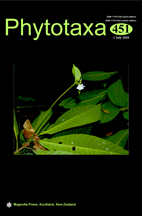Abstract
The state West Bengal, India was thoroughly investigated and a total of ten specimens belonging to the genus Chlorophyllum was collected. Detailed morphological and molecular studies revealed that the collected specimens were distributed over three species among which two viz. Chlorophyllum hortense and C. molybdites were previously known from the region, and one, Chlorophyllum squamulosum sp. nov., is described herein as new to science. The new species is distinguished by its small plate-like squamules over the pileus coloured greyish brown to reddish brown or dark brown; truncate, hyaline basidiospores with a prominent germ-pore; relatively small (17–25 × 7.5–11.5 μm), clavate or spheropedunculate cheilocystidia; and a tightly packed hymeniderm type pileus covering. A comprehensive morphological description, field photographs of the basidiocarps, comparisons with phenotypically similar and phylogenetically related species and a phylogram showing the placement of each of the collected species are provided. Besides, earlier records of Chlorophyllum species from West Bengal as well as in India are consulted and information related to diversity of the genus in the country are discussed with notes on the previous records. An artificial dichotomous key is provided to aid in the identification of the presently available Chlorophyllum species in India.

